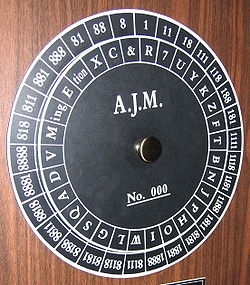
Cipher disk
Encyclopedia

DECIPHER
DECIPHER is a web-based resource and database of array comparative genomic hybridization data from analysis of patient DNA. It documents submicroscopic chromosome abnormalities, including microdeletions and duplications, from over 6000 patients and maps them to the human genome using the Ensembl...
ing tool developed in 1470 by the Italian architect and author Leon Battista Alberti. He constructed a device, (eponymously called the Alberti cipher disk
Alberti cipher disk
thumb|right|250px|A Treatise on Ciphers. The Alberti Cipher Disk.The Alberti cipher disk, also called formula, is a cipher disc which was described by Leon Battista Alberti in his treatise De Cifris of 1467...
) consisting of two concentric circular plates mounted one on top of the other. The larger plate is called the "stationary" and the smaller one the "moveable" since the smaller one could move on top of the "stationary" . The first incarnation of the disk had plates made of copper and featured the alphabet, in order, inscribed on the outer edge of each disk in cells split evenly along the circumference of the circle. This enabled the two alphabets to move relative to each other creating an easy to use key. Rather than using an impractical and complicated table indicating the encryption method, one could use the much simpler cipher disk. This made both encryption and decryption faster, simpler and less prone to error.
Methods of Encryption
The cipher disk can be used in one of two ways. The code can be a consistent monoalphabetic substitution for the entire cipher or the disks can be moved periodically throughout the cipher making it polyalphabetic.For a monoalphabetic use, the sender and the person receiving the messages would agree on a cipher key
Key (cryptography)
In cryptography, a key is a piece of information that determines the functional output of a cryptographic algorithm or cipher. Without a key, the algorithm would produce no useful result. In encryption, a key specifies the particular transformation of plaintext into ciphertext, or vice versa...
setting (e.g., the "G" in the regular alphabet would be positioned next to the "Q" in the cipher alphabet). The entire message is then encoded according to this key.
In addition to simple substitution cipher
Substitution cipher
In cryptography, a substitution cipher is a method of encryption by which units of plaintext are replaced with ciphertext according to a regular system; the "units" may be single letters , pairs of letters, triplets of letters, mixtures of the above, and so forth...
s, the cipher disk opened the way for convenient polyalphabetic cipher
Polyalphabetic cipher
A polyalphabetic cipher is any cipher based on substitution, using multiple substitution alphabets. The Vigenère cipher is probably the best-known example of a polyalphabetic cipher, though it is a simplified special case...
s. An easy way to do this is for the sender and the recipient to agree that a certain number of characters into the message, the scales would be shifted one character to the right, repeating the procedure every tenth letter. This would make it more difficult to crack, using statistical methods.
Variations
Cipher disks had many small variations on the basic design. Instead of numbers occasionally they would use combinations of numbers on the outer disk with each combination corresponding to a letter. To make the encryption especially hard to crack, the advanced cipher disk would only use combinations of two numbers. Instead of 1 and 2 though, 1 and 8 were used since these numerals look the same upside down (as things often are on a cipher disk) as they do right side up. You can see this on the Union disk above.Cipher disks would also add additional symbols for commonly used combinations of letters like "ing", "tion", and "ed". Symbols were also frequently added to indicate "and" at the end of a word.
Civil War
During the Civil War, military officers were incredibly naïve about how they used cipher disks. Instead of agreeing on a key beforehand, the keys seem to have been chosen by the sender and then transmitted to the receiver at the top of the encoded message . In essence, if you could intercept a message between two officers, you would definitely be able to read it. Also, the Confederates were savvy of the Northerners system of encryption and it is highly likely that they captured many of the disks that the Northerners were using at the time.Problems with Cipher Disks
When encoding a message using a cipher disk, a character is always used to mean “end of word.” The frequency of said character is abnormally high and thus easily detected. If this character, however, is omitted, then the words run together and it takes much longer for the recipient to read the message. To remedy this, some cipher disks now have multiple characters that stand for "end of word." Similarly a cipher disk may also have multiple characters that could be used for the letter "e" (the most common letter in English) so that instead of having a character with a frequency of roughly 13%, there would be two characters that stood for "e" - each with a frequency of 6% or so.Popular culture
Since the 1930s, cipher disks have been labeled "decoders" and have been used for novelties. Many of the cipher disks that were radio premiumsRadio Premiums
During the time that radio programs were the dominant medium in the United States, some programs advertised "souvenirs" of the various shows, which were sometimes called radio premiums...
were called "secret decoder ring
Secret decoder ring
A secret decoder ring is a device which allows one to decode a simple substitution cipher - or to encrypt a message by working in the opposite direction....
s."

